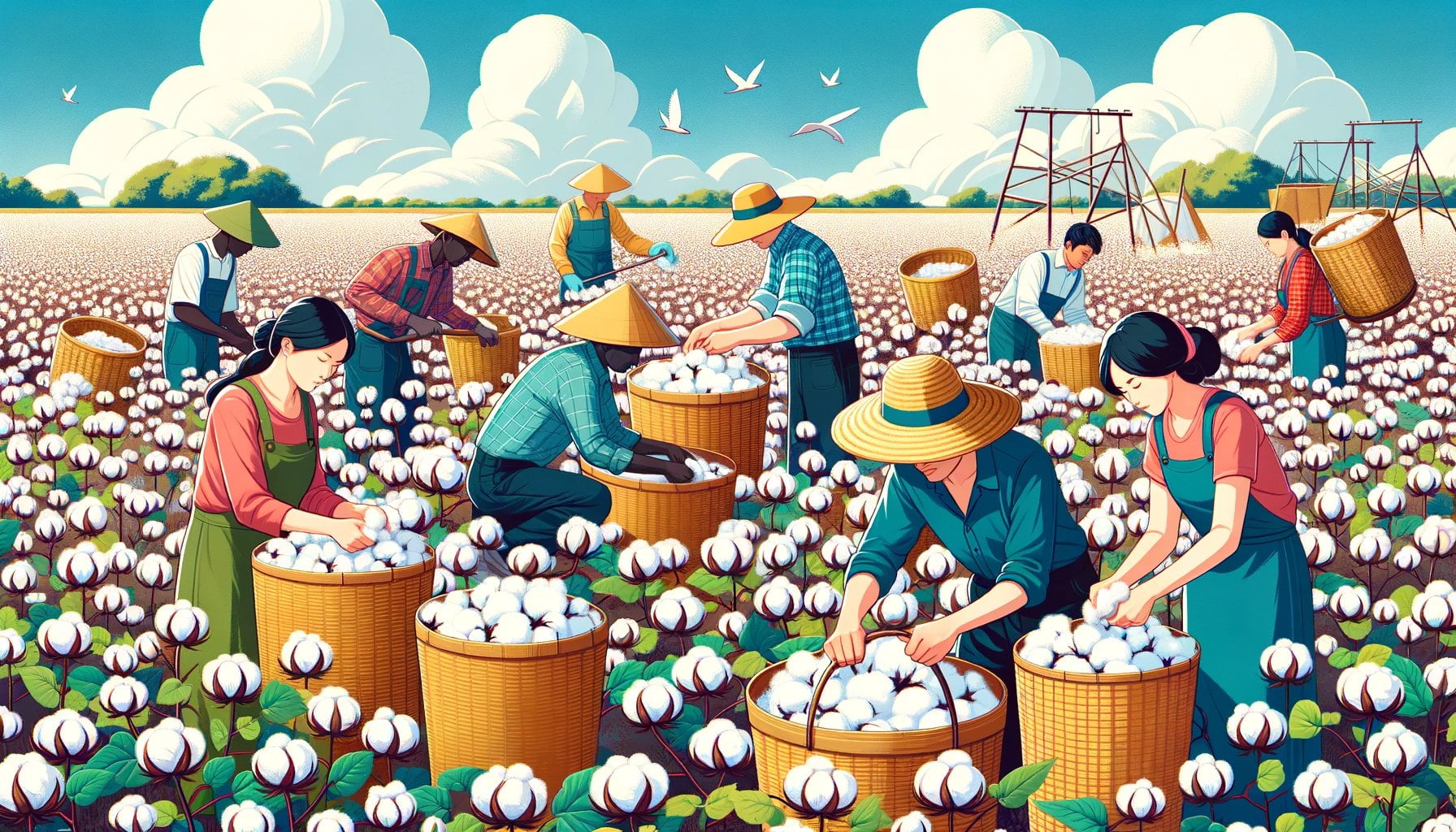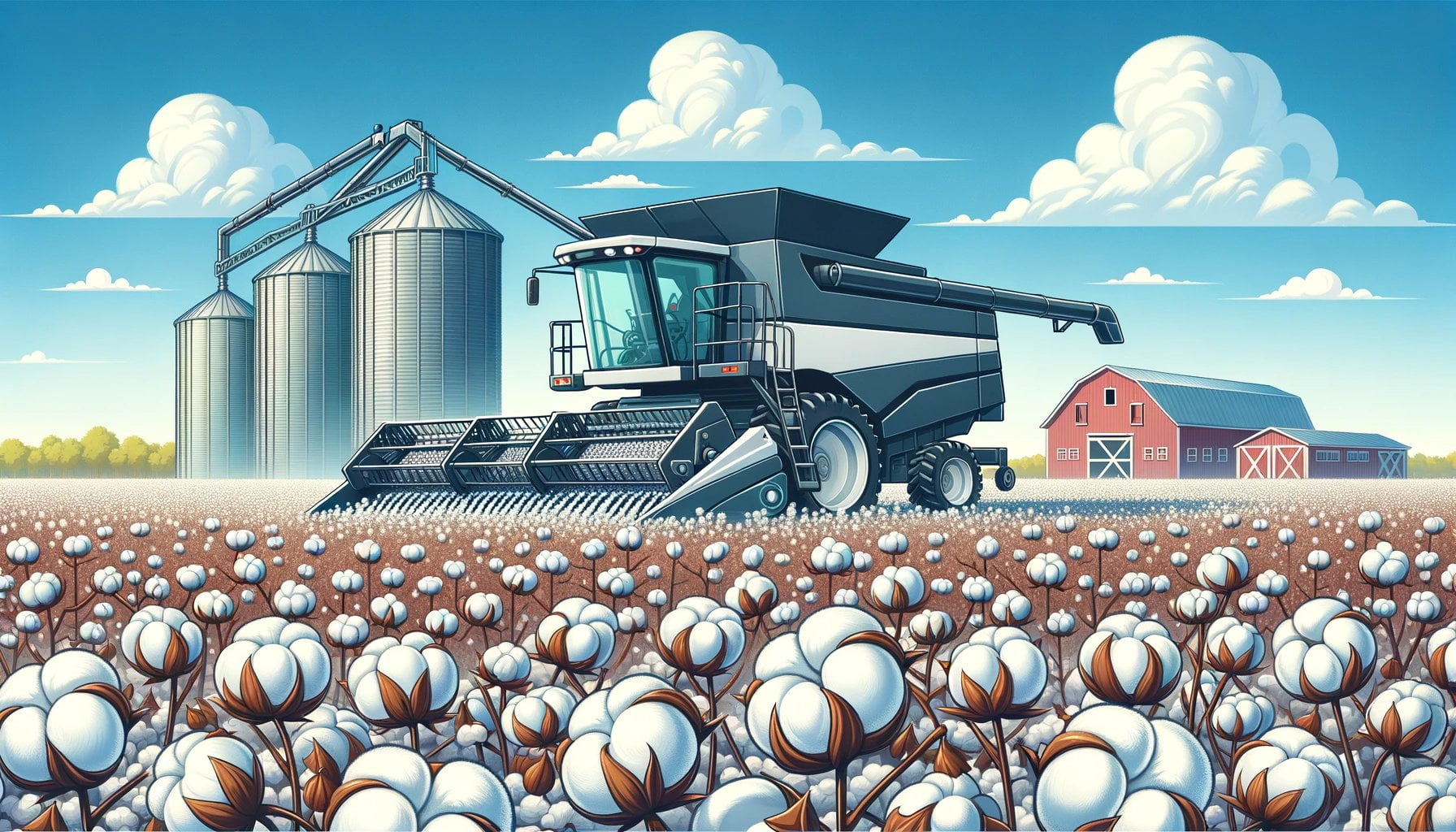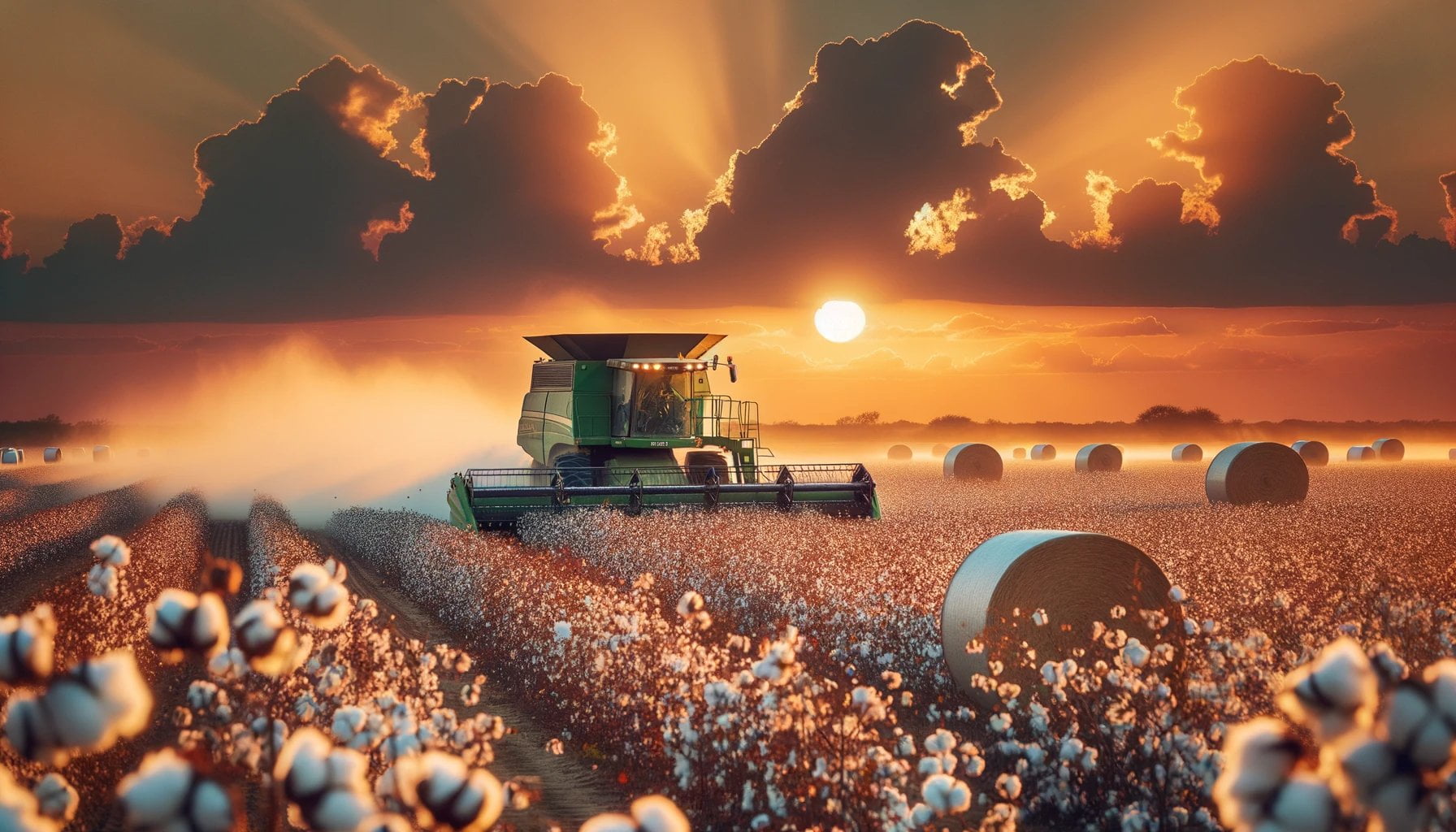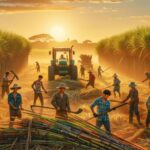Discover the fascinating world of cotton harvesting as we delve into the intricacies of this essential agricultural process. In this in-depth exploration, we will uncover the techniques and machinery used to harvest cotton, revealing the remarkable craftsmanship and technology behind its cultivation. From the initial planting to the meticulous picking of the fibers, we will unravel the secrets of how cotton is harvested. Join us on this educational journey as we shed light on the intricacies of cotton harvesting and gain a deeper appreciation for the hard work and skill that goes into ensuring a bountiful cotton harvest.

Key Takeaways:
- Cotton harvesting in the United States is primarily done using machines, with hand labor no longer used in the process.
- Two types of harvesting machines commonly used are cotton pickers and cotton strippers.
- Cotton pickers have spindles that twist the seed cotton from the bolls, leaving the plant intact in the field.
- Cotton strippers have rollers or brushes that remove the entire boll from the plant, along with leaves and branches.
- Once the cotton is harvested, it is formed into a module and transported to the processing plant.
- Cotton harvesting in the United States typically begins in July in southern Texas and in October in more northern areas of the country.
How is Cotton Harvested?
Cotton harvesting is a significant process in the cotton industry, where machines have transformed the way cotton is harvested. In the United States, hand labor is no longer used, and two main types of machines are employed: cotton pickers and cotton strippers.
Cotton Pickers:
Cotton pickers are machines designed to twist the seed cotton from the bolls, ultimately leaving the plant intact in the field. These machines effectively remove the seed cotton from the bolls while leaving the burrs (dried locules) behind. The leftover burrs may later be addressed during the ginning process.
Cotton Strippers:
On the other hand, cotton strippers employ rollers or brushes to take the entire boll from the cotton plant, along with its leaves and branches. These machines collect the bolls using rollers equipped with bats and brushes, effectively separating the “seed cotton” from the boll and other debris. The seed cotton is then directed into a basket by the cotton stripper.
Regardless of the method employed, after cotton is harvested, it is formed into a module and then transported to the processing plant. Cotton harvesting typically begins in July in southern Texas and later in October in more northern regions of the country.
Understanding the Cotton Harvesting Process:
To better comprehend the intricacies of cotton harvesting, let’s delve into each process more deeply.
1. Cotton Picking:
When cotton pickers are used, the machines primarily focus on twisting the seed cotton from the bolls, leaving the plant itself intact. What remains in the field are the burrs, which are dried locules that housed the cotton seeds. Later, during the ginning process, these burrs are separated from the harvested cotton.
2. Cotton Stripping:
Cotton stripping involves a slightly different approach. The cotton stripper utilizes rollers or brushes to remove the entire boll from the plant, including the leaves and branches. As the cotton stripper collects the bolls, it employs rollers equipped with bats and brushes to extract the “seed cotton” from the boll and other unwanted material. This carefully separated “seed cotton” is then directed into a basket.
Regardless of the harvesting method chosen, every cotton plant has the seed cotton removed, leaving only the plant’s essential components behind.
The Role of Harvesting Machines:
Cotton pickers and cotton strippers play a vital role in the cotton harvesting process. By mechanizing the harvest, efficiency is increased, and the need for manual labor is eliminated. These machines are equipped with advanced technology and mechanisms specifically designed to handle the delicate process of extracting the seed cotton while minimizing damage to the plant.
Benefits of Mechanical Harvesting:
Mechanical harvesting offers several advantages over traditional hand labor:
- Efficiency: The use of machines enables faster harvesting, reducing the time required to collect vast amounts of cotton.
- Cost-effectiveness: Mechanization decreases labor costs, allowing farmers to allocate their resources effectively.
- Preserving Plant Health: With careful design, cotton picking and stripping machines can extract the seed cotton without causing significant damage to the plant, ensuring the plant’s future growth.
- Improved Quality: By utilizing machines, cotton can be harvested under optimal conditions, leading to a higher quality product.
Conclusion:
Cotton harvesting has evolved significantly with the introduction of mechanized techniques. Whether using cotton pickers or cotton strippers, these machines efficiently separate the valuable seed cotton from the bolls, paving the way for further processing. The use of harvesting machines has revolutionized the cotton industry, facilitating a more efficient and productive approach to cotton harvesting.
Here are some interesting facts about sugar and corn syrup:
- How is sugar harvested? Did you know that sugar comes from sugarcane or sugar beets? Find out the fascinating process behind sugar production and how it is harvested.
- How is sugar grown? Sugar is not just magically created, it starts from the ground up. Discover the journey of sugar from seed to harvest and learn how it is grown.
- Fun fact about sugar Did you know that sugar is not only a sweet delight but also has some surprising uses? Explore some interesting facts and surprising applications of sugar that you might not have known before.
- Fun fact about corn syrup Corn syrup is a common ingredient in many everyday products, but there’s more to it than meets the eye. Uncover some intriguing facts about corn syrup and its role in various industries.
So, go ahead and click on the links to satisfy your curiosity and expand your knowledge about sugar and corn syrup!
The Intricacies of Cotton Harvesting: Techniques and Machinery Revealed
In modern cotton farming, the most common method employed for cotton harvesting is mechanical harvesting using cotton pickers. This method has revolutionized the cotton industry, providing increased efficiency and productivity compared to traditional hand labor. So, let’s dive into the world of cotton harvesting and explore the techniques and machinery involved.
Mechanical Harvesting: Cotton Pickers and Cotton Strippers
Mechanical cotton harvesters play a crucial role in removing the seed cotton from open bolls, leaving the plants in the field. There are two main types of mechanical cotton harvesters: cotton pickers and cotton strippers.
Cotton pickers are designed to selectively pick the cotton from the bolls while leaving the plant intact. These machines twist the seed cotton from the bolls, separating them from the plant. On the other hand, cotton strippers strip the entire plant of both open and unopened bolls, along with leaves and stems, using rollers or brushes. Both types of harvesters are equipped with advanced technology and mechanisms to extract the seed cotton while minimizing plant damage.
Progress and Advancements in Mechanical Cotton Harvesting
The concept of mechanical cotton harvesting is relatively recent but has rapidly replaced hand harvesting in countries like the United States. The first mechanized cotton picker was manufactured by John Rust in the 1930s, marking a significant milestone in the industry. Since then, multiple manufacturing companies, such as John Deere, have developed modern cotton harvesting machines.
Mechanical cotton harvesting has also made significant progress in countries like Turkey in the past decade. Furthermore, ongoing research and development focus on the adoption of robotics and other mechanical harvesting technologies in cotton harvesting.
The Advantages of Mechanical Harvesting
Mechanical harvesting offers several advantages over traditional hand labor. Firstly, it significantly improves efficiency and productivity in the cotton industry. These machines are capable of handling large quantities of cotton, reducing the need for manual labor and increasing overall output.
Secondly, mechanical harvesting ensures cost-effectiveness. By automating the cotton harvesting process, farmers can save on labor costs and streamline their operations.
Thirdly, mechanical harvesting helps preserve plant health. With the selective picking or stripping of cotton from the bolls, plants can continue to grow and produce more cotton in subsequent harvests. This also avoids potential damage caused by manual harvesting methods.
Lastly, mechanical harvesting improves the quality of harvested cotton. By using advanced technology and techniques, these machines are designed to pick or strip cotton more efficiently, resulting in a higher-quality yield.
Key Takeaways:
- Mechanical harvesting using cotton pickers is the most common method employed in modern cotton farming.
- Two main types of mechanical cotton harvesters are cotton pickers and cotton strippers.
- Cotton pickers selectively twist the seed cotton from the bolls, leaving the plant intact.
- Cotton strippers remove the entire boll from the cotton plant using rollers or brushes.
- Mechanical cotton harvesting has replaced hand harvesting in developed nations like the USA, Australia, Brazil, and Russia.
- Ongoing research focuses on the adoption of robotics and other mechanical harvesting technologies in cotton harvesting.
- Mechanical harvesting offers efficiency, cost-effectiveness, plant health preservation, and improved quality compared to traditional hand labor.
Sources:
1. CottonWorks™ – Cotton Processing: Harvesting
2. Britannica – Cotton Harvester
The Intricacies of Cotton Harvesting: Techniques and Machinery Revealed
Cotton harvesting is a crucial step in the processing of cotton and marks the culmination of months of planting and tending. It involves the delicate process of picking cotton bolls from the plants, a task that demands expertise and careful consideration. In this article, we will delve into the intricacies of cotton harvesting, exploring the various techniques and machinery involved.
Cotton Harvesting Methods: Strippers and Pickers
There are two main methods used for cotton harvesting: cotton strippers and cotton pickers. Each method employs different machinery to efficiently harvest the cotton bolls.
Cotton Strippers:
Cotton strippers remove the entire boll from the cotton plant using rollers or brushes. As they pass over the plants, the strippers skillfully extract the bolls, leaving behind the empty burs and unopened bolls on the plant. This method is known for its efficiency and ability to harvest large quantities of cotton at a time.
Cotton Pickers:
On the other hand, cotton pickers selectively twist the seed cotton from the bolls while leaving the plant intact. These self-propelled machines are equipped with special heads that carefully separate the cotton from the plant. The seed cotton is then collected in a basket, ready for further processing. This method allows for a more personalized approach to the harvesting process, ensuring that each boll is handled with care.
The Importance of Timing
Timing plays a crucial role in cotton harvesting. Picking the cotton at the right moment is essential to maintain the quality and traceability of the cotton from the gin to the mill. Harvesting too soon can disrupt this journey and affect the overall quality of the cotton. Therefore, it is vital to wait until the moisture from dew or rain has dried before initiating the harvesting process.
Factors Affecting Fiber Quality
Several factors influence the fiber quality in cotton harvesting and ginning. These include the variety of cotton, geographical climate parameters, traditional practices, harvesting and storage experiences, moisture and trash content, and the technology used in the ginning process. These factors must be carefully considered by cotton farmers to ensure optimal quality and market value for their cotton yield.
Mechanical Harvesting Techniques
Mechanical cotton harvesters have revolutionized the cotton industry, making the harvesting process more efficient and productive. With the advancement of technology, modern cotton pickers and strippers use sophisticated mechanisms to extract the seed cotton while minimizing plant damage. This shift from traditional hand labor to mechanized techniques offers increased efficiency, cost-effectiveness, and plant health preservation.
Storing the Harvested Seed Cotton
Once the seed cotton has been harvested, it is crucial to store it properly before it is delivered to the gin. Adequate storage facilities must be in place to protect the seed cotton from moisture, pests, and other potential risks. Proper storage ensures the preservation of the cotton’s quality until it is ready for processing.
Key Takeaways:
- Cotton harvesting involves the intricately delicate process of picking cotton bolls from the plants.
- There are two main methods of cotton harvesting: cotton strippers and cotton pickers.
- Cotton strippers remove the entire boll from the plant, while cotton pickers selectively twist the seed cotton from the bolls, leaving the plant intact.
- Timing is crucial in cotton harvesting to maintain quality and traceability.
- Various factors, such as variety, climate, traditional practices, and ginning technology, affect fiber quality in cotton harvesting.
- Mechanical harvesting techniques offer increased efficiency, cost-effectiveness, and plant health preservation.
- Proper storage facilities are essential to protect the harvested seed cotton before it is delivered to the gin.
Sources:
1. CottonWorks™ – “Cotton Processing: Harvesting”
– URL: Cotton Processing: Harvesting
- SpringerLink – “The Harvesting and Ginning of Cotton”
- URL: The Harvesting and Ginning of Cotton
The Intricacies of Cotton Harvesting: Techniques and Machinery Revealed
Cotton, one of the most widely used natural fibers in the world, undergoes a fascinating journey from harvesting to fabric creation. In this article, we will explore the various stages of cotton processing and the machinery involved, shedding light on the intricate process that transforms this humble crop into the high-quality fabric we all know and love.
Harvesting: The First Step
The journey of cotton begins with harvesting, an important milestone for farmers. After months of planting and tending to the cotton crop, the time has come to collect the fruits of their labor. Harvesting is a delicate process, and the timing is crucial to ensure optimal yield and preserve the quality of the cotton fibers. Once the cotton crop matures, it is recommended to deliver the cotton products to the cotton-ginning factory as quickly as possible after each harvest (CottonWorks).
The Importance of Cotton Harvesting
Why is cotton harvesting so significant? It’s because this process ensures that the cotton crop is collected before weather conditions can damage its quality and reduce its yield. In the United States, machine harvesting is commonly used, with the process starting in July in south Texas and in October in more northern areas of the Belt. By utilizing cotton pickers, the seed cotton is removed from the bolls, leaving the burrs behind in the field (Cotton: From Field to Fabric).
Ginning: Separating Fibers from Seeds
After the cotton is harvested, it undergoes the process of ginning, a crucial step in separating the cotton fibers from the seeds. Ginning involves several stages, including drying and cleaning the seed cotton, mechanically separating the fibers from the seeds, and further cleaning and packaging the fibers for commercial use. This meticulous process helps remove impurities such as dirt, leaves, and remaining seed fragments, ensuring that the cotton fibers are ready for further processing (Cotton Harvesting Methods and Cotton Ginning Procedures).
Various Stages of Processing
After ginning, the cotton fibers are now prepared for further processing that will ultimately transform them into a final product. This journey involves multiple stages, including carding, combing, and spinning. Carding aligns the fibers and removes any remaining impurities, ensuring uniformity. Combing further refines the cotton fibers by removing short fibers and creating a smoother, more luxurious thread. Finally, spinning combines the cotton fibers to form yarn that can be used for weaving or knitting purposes. These stages of processing are instrumental in creating high-quality cotton fabric suitable for various applications.
Key Takeaways:
- Harvesting marks an important milestone in the cotton production process, ensuring that the cotton crop is collected before weather conditions can damage its quality and reduce its yield.
- Machine harvesting, through the use of cotton pickers, has revolutionized the industry by efficiently removing seed cotton from the bolls while leaving behind burrs.
- Ginning plays a vital role in separating cotton fibers from seeds, removing impurities and preparing the fibers for further processing.
- The journey of cotton doesn’t end with ginning; it involves additional stages like carding, combing, and spinning, which contribute to the creation of high-quality cotton fabric.
With each passing year, the cotton industry continues to evolve and embrace new techniques and machinery. From harvesting to fabric creation, this intricate process showcases the craftsmanship and dedication of cotton farmers and the technological advancements that have made the journey of cotton possible.

FAQ
Q1: What are the two main methods of cotton harvesting?
A1: The two main methods of cotton harvesting are cotton strippers and cotton pickers.
Q2: How do cotton strippers harvest cotton?
A2: Cotton strippers have rollers or brushes that remove the entire boll from the plant, along with leaves and branches.
Q3: How do cotton pickers harvest cotton?
A3: Cotton pickers have spindles that twist the seed cotton from the bolls, leaving the plant intact in the field.
Q4: What happens to the harvested cotton after it is collected?
A4: Once the cotton is harvested, it is formed into a module and transported to the processing plant.
Q5: When does cotton harvesting typically occur in the United States?
A5: Cotton harvesting in the United States typically begins in July in southern Texas and in October in more northern areas of the country.
















